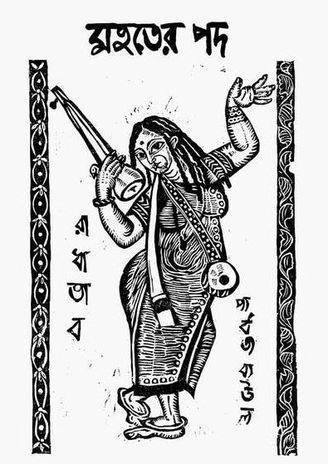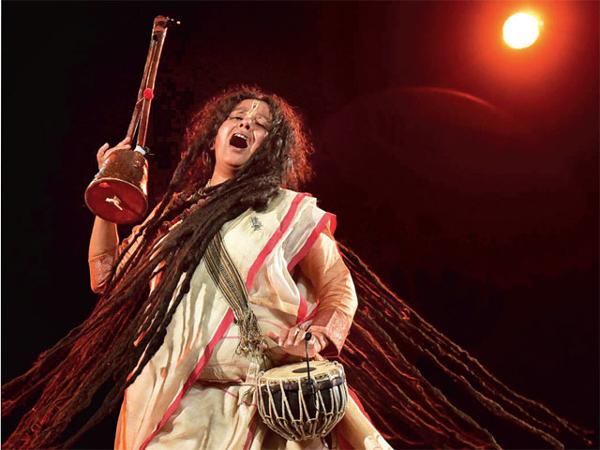Parvathy Baul
To be a Praner Manush (A person of the Heart)
The Divine Madmen

The Bauls -- a group of mystic minstrels from Bengal -- set in motion a movement so subtle, and yet powerful that territorial boundaries have ceased to matter : geographical (India - Bangladesh), sectarian (Vaishnava Hindus and Sufi Muslims) or definitional (religious, cultural, spiritual) merge when it comes to the Bauls. A handful of such Bauls across generations have shaped the Bangla culture in such myriad ways that it is indeed one of the masterpieces of oral and intangible heritage of humanity. Tagore articulates the core belief of the Bauls :
Amar praner manush achhé prané Tai heri taye sakol khane
Achhe shé nayōntaray, alōk-dharay, tai na haraye--
Ogo tai dekhi taye jethay sethay Taka-i ami jé dik-pané
The man of my heart dwells inside me. Everywhere I behold, it's Him!
In my every sight, in the sparkle of light. Oh I can never lose Him --
Here, there and everywhere, Wherever I turn, right in front is He!
Rightfully called "The Honey Gatherers," Parvathy Baul, born Moushumi Parial, is one such practitioner and teacher of the Baul tradition. She is also an instrumentalist, storyteller and painter. Dressed in a traditional Saree with a tilak on her forehead, untied, matted long hair, holding a single-stringed Iktara and a small duggi drum in her hand, and playing it beautifully, Parvathy Das Baul’s appearance on the stage dazzle her audience. She has offered her performances in over forty countries. Her music enthrals audiences from all over the nation beyond the seas. “Kichu din mone mone”, “Sri charon pabo bole” and “Ghiri ghiri ghiri nache” are a few of the most loved songs.
Over more than three decades, Parvathy has had a graceful journey of devotion and represents the melodious Baul tradition. She stumbled upon Baul music through a blind Baul strumming an ektara while on a train journey to Bolpur. Though her gurus (octogenarian Sanatan Das Baul and 97-year old Shoshanko Goshai) were rather unwilling to accept a female disciple, her deep inquiry into the Baul tradition and her spirit of surrender convinced them to accept her as their disciple.
 Parvathy's current life-work is to preserve this tradition by curating the various Baul songs which have been relayed through oral traditions. Her work has taken shape through Ekathara Kalari, her non-profit institution promoting ancient Indian spiritual traditions, with an emphasis on Baul arts and practice and Tantidhatri, a conglomeration of ‘women who hold the strings’ to celebrate women who perform art forms. An ashrami herself, she is currently instrumental in giving life to Sanatan Siddhashram, named after her Guru Sanatan Das Baul as a tribute to Sanatan Das Baul’s vision of having an ashram for minstrel Bauls.
Parvathy's current life-work is to preserve this tradition by curating the various Baul songs which have been relayed through oral traditions. Her work has taken shape through Ekathara Kalari, her non-profit institution promoting ancient Indian spiritual traditions, with an emphasis on Baul arts and practice and Tantidhatri, a conglomeration of ‘women who hold the strings’ to celebrate women who perform art forms. An ashrami herself, she is currently instrumental in giving life to Sanatan Siddhashram, named after her Guru Sanatan Das Baul as a tribute to Sanatan Das Baul’s vision of having an ashram for minstrel Bauls.
The paths charted by the wayward seem strange. And why not, when the word Baul has its origin in the Sanskrit word Vatula ("mad", from vayu - "air" or "wind") and is used for someone who is possessed or crazy, or from Vyakula, which means "restless, agitated." No wonder that Tagore writes,
"That is why, brother, I became a madcap Baul. No master I obey, nor injunctions, canons or custom. Now no men-made distinctions have any hold on me, And I revel only in the gladness of my own welling love. In love there's no separation, but co-mingling always. So I rejoice in song and dance with each and all."
.jpg)
"Make your life into a prayer." — Sanatan Das Baul
Join us this weekend in conversation with Parvathy Baul moderated by one of our volunteers, Gayathri, as they talk about the Baul way of life.
Five Questions with Parvathy Baul